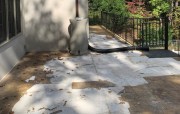Knowing how much concrete shrinks, a big industrial concrete slab without joints or cracks seems nearly impossible. But that’s just what was being promised by the panel at the Quality in Concrete Slabs Luncheon at World of Concrete, discussing five different approaches to the same end result. Whether using steel fibers, macrofibers, shrinkage-compensating concrete, or one of the proprietary systems (Ductilcrete or PrimXComposite) all of the panelists had examples of successful extended-joint slabs.
If these slabs have been perfected, I asked, why are we still cutting joints? “I’d be rich if I had a nickel for every time someone has said to me ‘I don’t want to be the guinea pig,’” said Mike Gresser, Gresser Concrete and PrimXComposite. The prevailing opinion on the panel was that it’s just a matter of knowledge and that perhaps sessions like the luncheon will begin to get the word out. In my blog immediately after WOC, I perhaps-too-enthusiastically wrote that “the only thing holding this back is the willingness of engineers and owners to take a chance, even though chance has little to do with it today.”
The promise of joint-free slabs is great, still, some healthy skepticism is always appropriate. After listening to all the arguments, one knowledgeable observer noted that one of the keys to success is control over the entire installation, from design to construction to maintenance, and still he has observed some longer-term problems with some of these slabs. An important issue is that it only takes one extended-joints project to go south and everybody hears about it. And I agree that the objective is a curl-free and crack-free slab after five or more years not just two weeks after construction. We’ll keep an eye on these slabs and let you know if any problems pop up.
-
Infrastructure is Civilization
A new conference seeks to improve infrastructure design and construction

-
Tall Wood Buildings
The concrete industry needs your comments on a proposed code change

-
Getting Published
Catching this editor's attention takes a little strategy.

-
Addicted to Concrete
The general media's misunderstanding of concrete is nothing new but we still need to try.

-
A Platform for Innovation
The SDC plans to take on no less than the future of concrete.

-
Infrastructure that Lasts
What does a 100-Year service life really mean?

-
Dust-Free Zone
Do you know how to comply with the new rules on silica dust?




